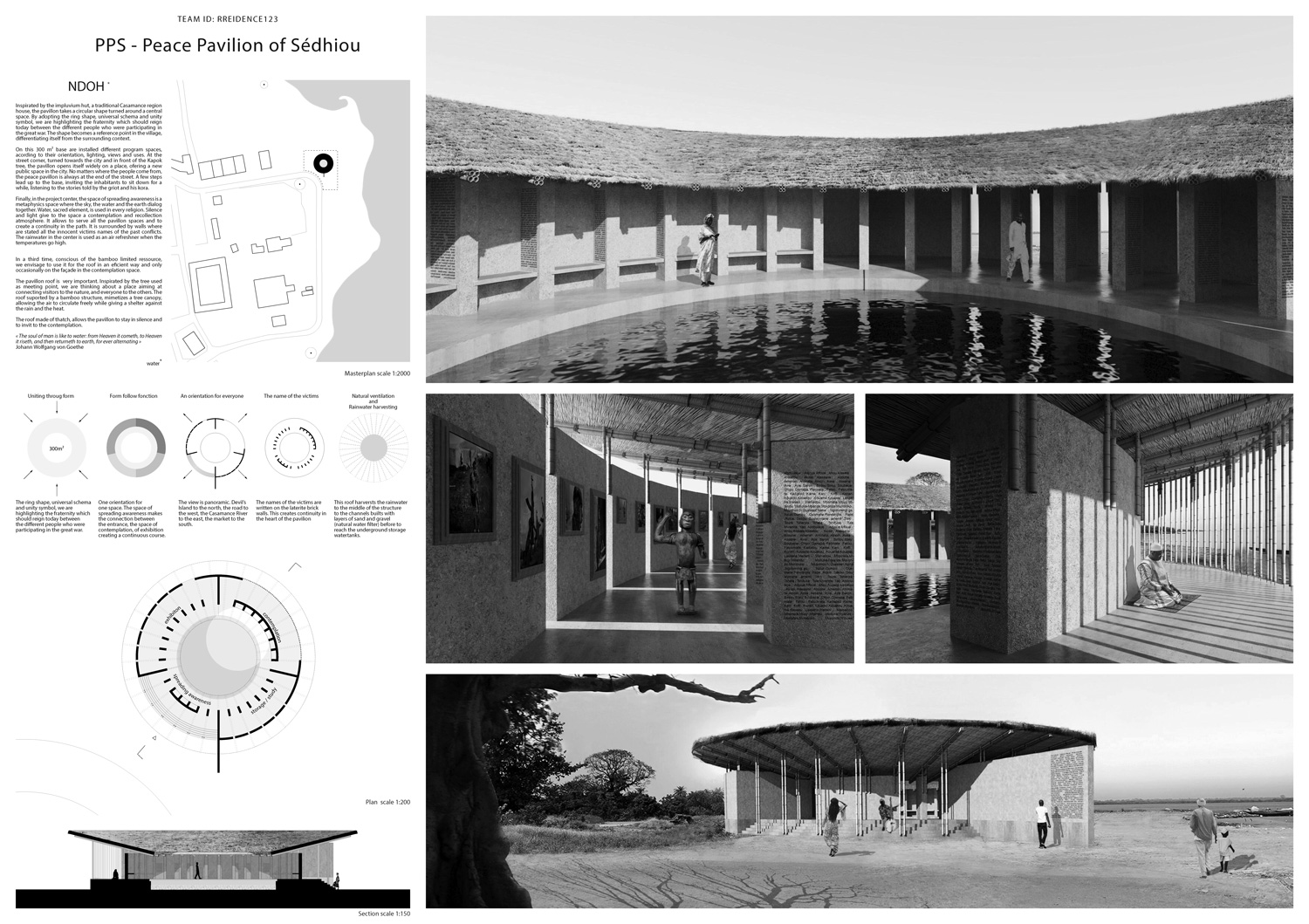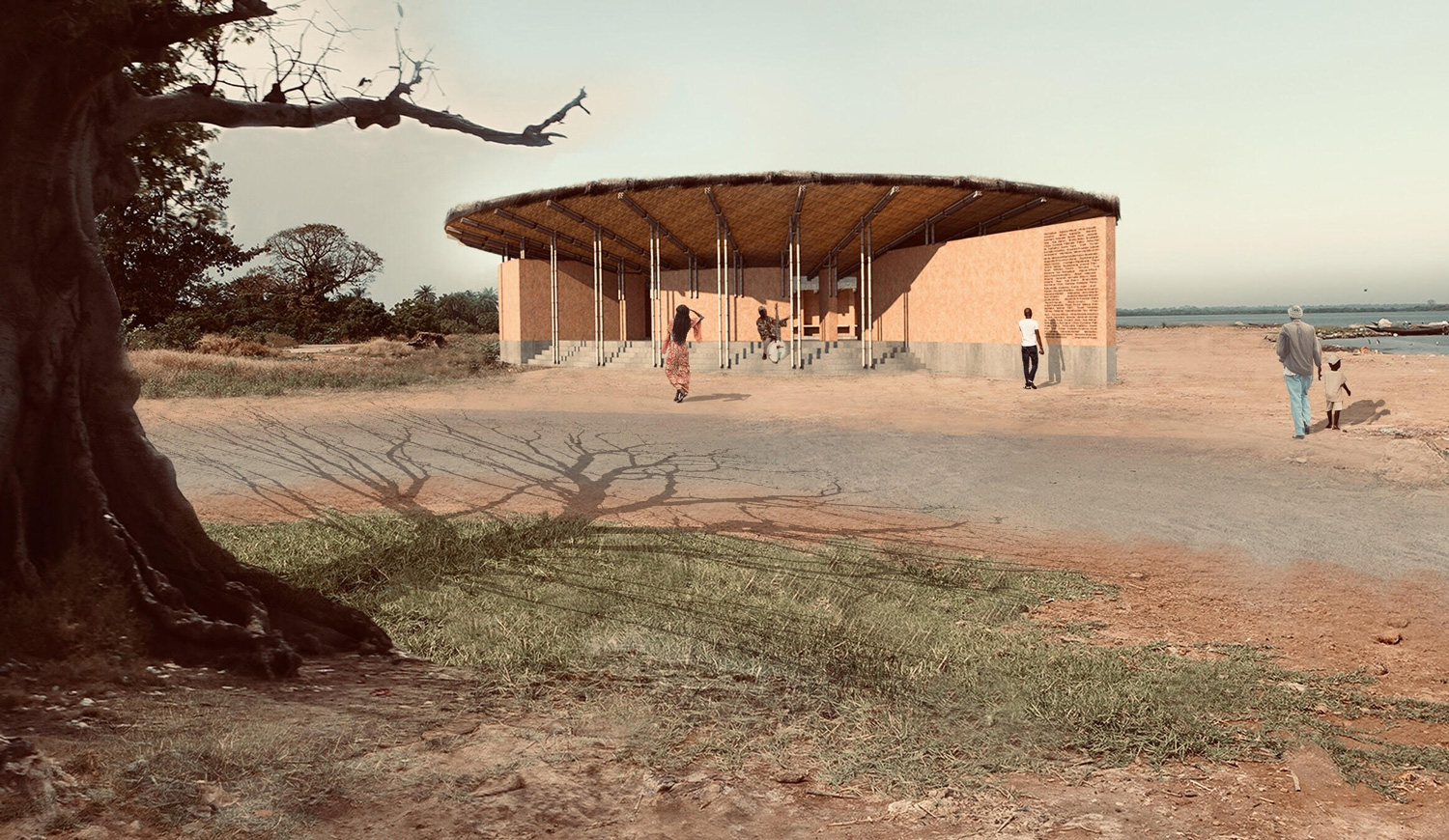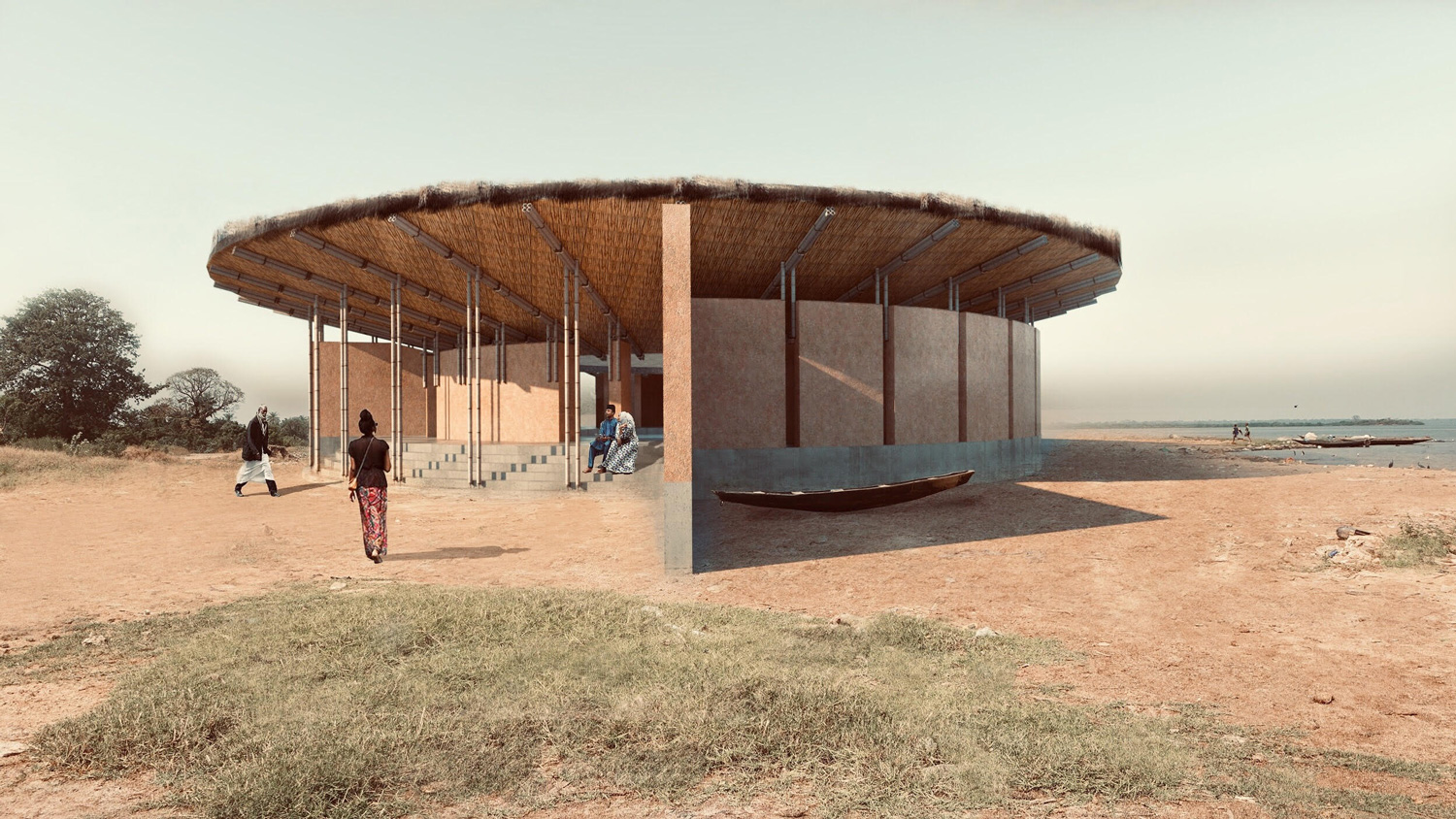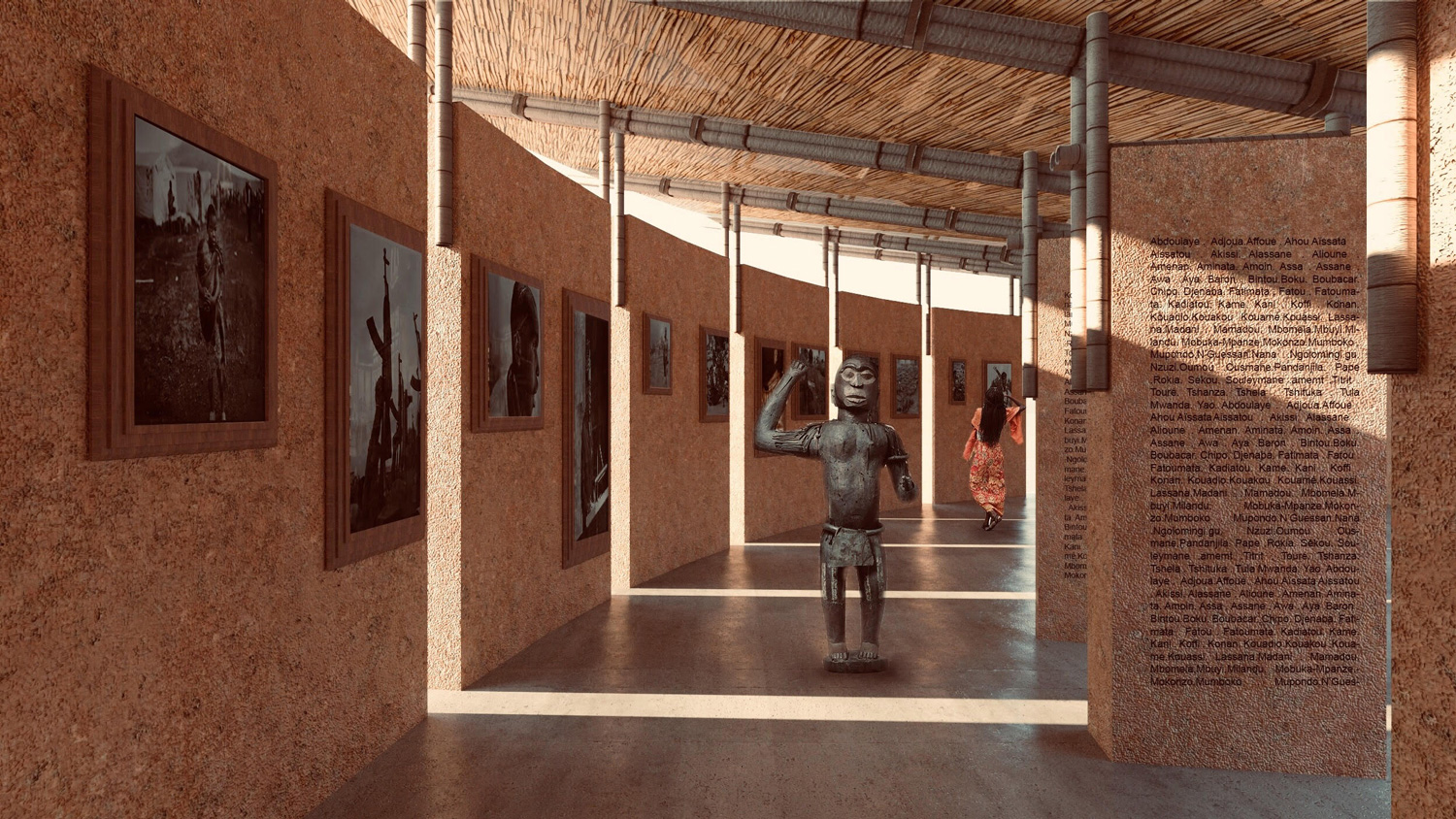2510-PID-SN-2019
Client: Kaira Looro
Status: Competition (2019)
Location: Sedhiuo, Senegal
Coordinates: 12.7080556,-15.556944
Climate: Hot, Tropical
Materials: Ceramic, Wood
Environment: Desert
Visualizer: Studio
Budget: 15.000 m2
Scale: 300 ㎡ Small
Ratio: 500,01 €/㎡
Types: Chapel, Religious
Sedhiou, once marked by the Casamance conflicts is the capital city of this region which now hosts the peace pavillon project. The city is followed by the river Casamance playing an important role in the inhabitants life and region economy. Its immensity dominates the flat senegalese landscape, and during three months a year, the rainy season floods the river, making the nature great again and changing the surroundings and the environment. The choice to set up the « peace pavillon » project on the river’s edges expresses a real will to build the peace and to gather people beyond the borders of the city, of the region and the country.
In deed, the land parcel lies on the river’s edges at one street corner used by the city principal market. This situation expresses itself equally to the Sedhiou inhabitants than to the river traveler. The peace pavillon becomes a symbolic element in the Casamance landscape, connecting the city with the architecture and the natural environment. This place of peace will become a reference point on the river and in the Sedhiou city. A gathering place, of contemplation and prayers.
The project is engaged in a sensitive approach of this developing country context. Inspirated by the impluvium hut, a traditional Casamance region house, the pavillon takes a circular shape turned around a central space. By adopting the ring shape, universal schema and unity symbol, we are highlighting the fraternity which should reign today between the different people who were participating in the great war. The shape becomes a reference point in the village, differentiating itself from the surrounding context.
A base allows the peace pavillon to be settled one meter above the natural ground. This elevation ensures the annual access to the pavillon, despite the rainy season. We dream to build an universal sphere, an opened space to everybody, which invites to the memory values and to the solidarity. An awareness and contemplation space where the peace can reign.
On this 300 m² base are installed different program spaces, acording to their orientation, lighting, views and uses. At the street corner, turned towards the city and in front of the Kapok tree, the pavillon opens itself widely on a place, ofering a new public space in the city. No matters where the people come from, the peace pavillon is always at the end of the street. A few steps lead up to the base, inviting the inhabitants to sit down for a while, listening to the stories told by the griot and his kora. Finally, a wall marks the public space and invites to enter in the peace pavillon. The exposition space is oriented north-west. Widely lightened, it opens occasionally and slightly on the rice fields to allow to the artistical works to be the center of the attention. A north wider opening is oriented towards the second Kopak tree. The space welcomes works from artist which share common values with the pavillon.
The contemplation space opens widely on the Devils Island, once spiritual retreat and on the river going towards the ocean. By praying in the pavillon, the visitor always stays outside, but is proteged from the rain and the burning sun.
The space is quiet, thanks to the thatch roof. The space is universal and opened to every culture, every gender,and every existing religion. To maintain the prayers intimacy, the view is divided by vertical bamboos. In the end of the day, the prayer is done in the shadow while the landscape and the river are illuminated by the sunset.
In south-east, there is the stock and / or study space. Finally, in the project center, the space of spreading awareness is a metaphysics space where the sky, the water and the earth dialog together. Water, sacred element, is used in every religion. Silence and light give to the space a contemplation and recollection atmosphere. It allows to serve all the pavillon spaces and to create a continuity in the path. It is surrounded by walls where are stated all the innocent victims names of the past conflicts. The rainwater in the center is used as an air refreshner when the temperatures go high. If there is no water for some time, the space can be used as a gathering space where the griot could tell historic events in order to sensitize the local and international community in this place of peace, commemoration and education.
« The soul of man is like to water : from Heaven it cometh, to Heaven it riseth, and then returneth to earth, for ever alternating » Johann Wolfgang von Goethe
The materials and implementation subjects have been thought in full respect of the project global economy. The pavillon represents what mankind can build with natural elements, celebrating natural events such as light or rain. In this way, our intention is to put value in the natural materials and local resources to simplify the constructive system (base, wall, roof).
The 300 m² base allowing the pavillon to be surelevated up to one meter above the natural ground is built of concrete. It would be poured on site or prefabricated acording of the easiest possibilities. It allows to separate the materials such as soil or bamboo from water.
Then, protected of the rain, laterite brick walls are built on this base. Bricks are disposed dry or by a morter (such as the laterite earth). The soil thermical performance allows to keep the pavillon space cool.
In a third time, conscious of the bamboo limited ressource, we envisage to use it for the roof in an eficient way and only occasionally on the façade in the contemplation space. Bamboos are put together by a weaving principle, shaping resistent beams enduring roof overhangs. Some bamboo posts are fixated on the concrete base by metal rods.
The pavillon roof is very important. Inspirated by the tree used as meeting point, we are thinking about a place aiming at connecting visitors to the nature, and everyone to the others. The roof suported by a bamboo structure, mimetizes a tree canopy, allowing the air to circulate freely while giving a shelter against the rain and the heat. The pavillon, with its vertical design, refers to the local nature and construction systems. Roof overhangs allow to protect the wall from the rain. The new modern impluvium hut interpretation takes once again all its meaning. This roof harversts the rainwater to the middle of the structure to the channels builts with layers of sand and gravel (natural water filter) before to reach the underground storage watertanks. The roof made of thatch, allows the pavillon to stay in silence and to invit to the contemplation.
The brief estimation of the costs shows a real attention to economy in the heart of the project : the concrete base made of gravels (1100€), cement (2586€) and sand (47,12€) costs 3733.44€ (importation included). The 6000 m² laterite bricks walls cost 2760€. The bamboo structure costs 1145€. Reeds under the roof cost 1943€. Thatch costs 1460€. The project total cost is estimated to a value of 11041,44 €.





